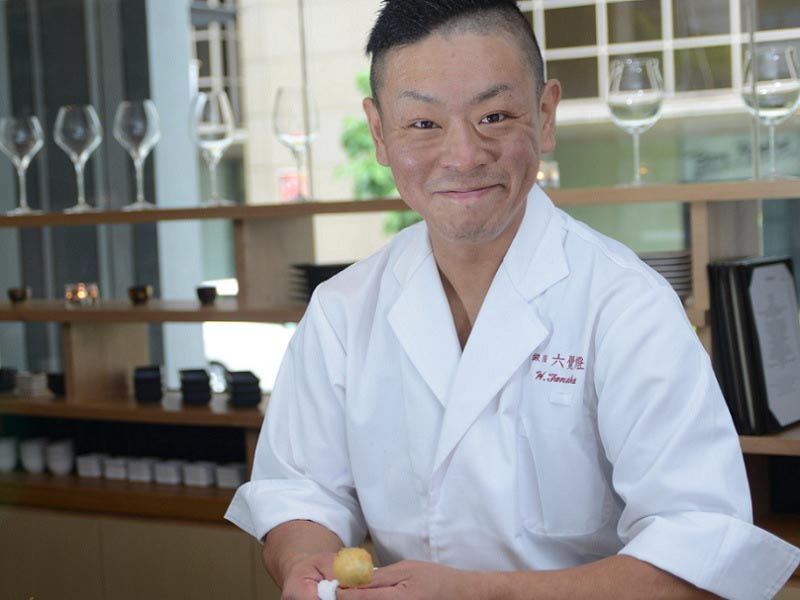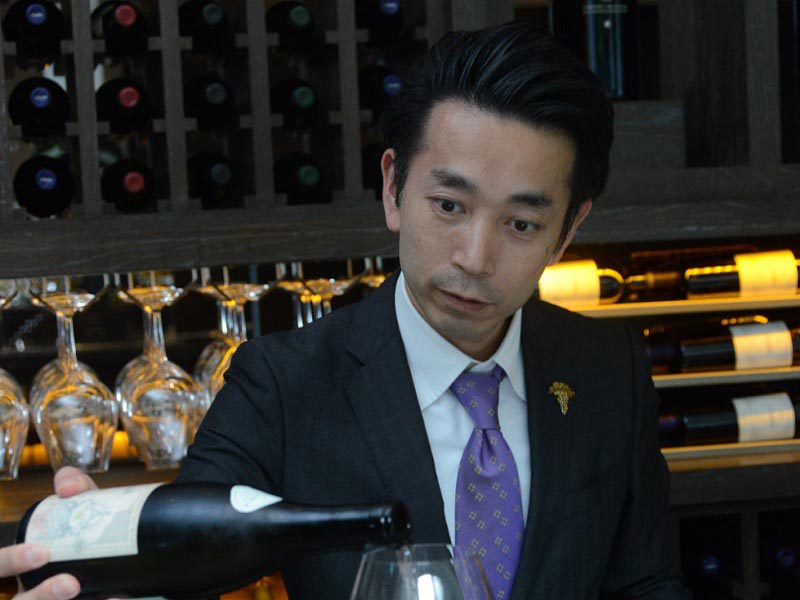Rokukakutei: Torch of Six Senses
by Qian Leung
@ 29 Dec 2017

Invented by the proprietress of a small bar in Osaka in 1929, kushikatsu (kushi for ‘skewer’, katsu for ‘cutlet’) consists of bite-sized portions of meat, seafood, and vegetables, breaded, and deep-fried. These were popular with labourers as they were quick, convenient, filling, and affordable. In 2009, a kushikatsu restaurant which had been quietly serving customers in Kuromon market in Osaka since the 1980s received a Michelin star. Today, you can experience for yourself this dining culture at
Rokukakutei’s outpost in Singapore. Its name means a ‘torch of six senses’, and signifies the hope to draw people through the light and warmth of the five senses, plus the sense of creating. Pick a seat by the counter and watch as chef dips skewers such as shrimp, wagyu beef, scallop, and green pea croquette into a batter of flour, milk, eggs, white wine, and water.

Each is then coated with panko breadcrumbs, and dropped into hot oil of 170 degrees Celsius. Since each chef has to serve up to thirty guests during dinner service, they need to keep their gaze constantly on the skewers that are turning golden, while being light on their feet to serve them to guests. “In the Osaka outlet, we receive a hundred guests every day,” says Chef Hideyuki Tanaka, 36, who has been serving kushikatsu for six years. “So the owner taught me to cook with the rhythm.” It does seem like he’s listening to an internal drumbeat, and lightly dancing to it, while he is frying, and delivering the skewers. If you’re wondering why your octopus is pointing to the soy sauce, the chicken breast is pointing to the mustard and lemon, and the smelt-whiting is pointing to the salt, that’s because it’s the recommendation of the chef for the dipping goes best with that particular skewer.

Sometimes, say, with the lotus root stuffed with beef, or the pork loin, you might find them pointing mid-way between the red wine sauce and the sesame sauce. “This means that either of these sauces would make a good choice,” says Chef Tanaka. Having said that, he feels that the fun of kushikatsu is in picking your own sauce. “What we recommend is just a suggestion.” While kushikatsu is traditionally enjoyed with beer or sake, at Rokukakutei, wines such as a riesling from Franz Hirtzberger, a grüner veltliner from Jurtschitsch, and sauvignon blanc from Tement (all three are wineries from Austria) are served. Of the ones we try, the 2014 Saint Aubin En L’Ebraupin, a chardonnay from Burgundy, is perhaps the most intriquing and delightful.

It tastes different with each bite - sweet with the green pea croquette, mineral-like with the octopus, and round and buttery with the chicken breast with mountain caviar. (This perhaps has to do with the dippings, which are sansho pepper salt, soy sauce, and mustard and lemon respectively.) Sommelier Suzuki Minoru, 42, brings out a merlot from Austrian winery Weninger. “This was bottled specially for Rokukakutei,” says Minoru, displaying the label, on which ‘Rokukakutei’ is printed. From the comfort food of olden-day Osaka to the wine-pairing cooking-as-theatre Michelin-starred experience of today, kushikatsu has come a long way. Yet, the heart of serving a bit of warmth to the hungry customer remains the same. May that flame burn ever brightly and never go out.
 Invented by the proprietress of a small bar in Osaka in 1929, kushikatsu (kushi for ‘skewer’, katsu for ‘cutlet’) consists of bite-sized portions of meat, seafood, and vegetables, breaded, and deep-fried. These were popular with labourers as they were quick, convenient, filling, and affordable. In 2009, a kushikatsu restaurant which had been quietly serving customers in Kuromon market in Osaka since the 1980s received a Michelin star. Today, you can experience for yourself this dining culture at Rokukakutei’s outpost in Singapore. Its name means a ‘torch of six senses’, and signifies the hope to draw people through the light and warmth of the five senses, plus the sense of creating. Pick a seat by the counter and watch as chef dips skewers such as shrimp, wagyu beef, scallop, and green pea croquette into a batter of flour, milk, eggs, white wine, and water.
Invented by the proprietress of a small bar in Osaka in 1929, kushikatsu (kushi for ‘skewer’, katsu for ‘cutlet’) consists of bite-sized portions of meat, seafood, and vegetables, breaded, and deep-fried. These were popular with labourers as they were quick, convenient, filling, and affordable. In 2009, a kushikatsu restaurant which had been quietly serving customers in Kuromon market in Osaka since the 1980s received a Michelin star. Today, you can experience for yourself this dining culture at Rokukakutei’s outpost in Singapore. Its name means a ‘torch of six senses’, and signifies the hope to draw people through the light and warmth of the five senses, plus the sense of creating. Pick a seat by the counter and watch as chef dips skewers such as shrimp, wagyu beef, scallop, and green pea croquette into a batter of flour, milk, eggs, white wine, and water.


